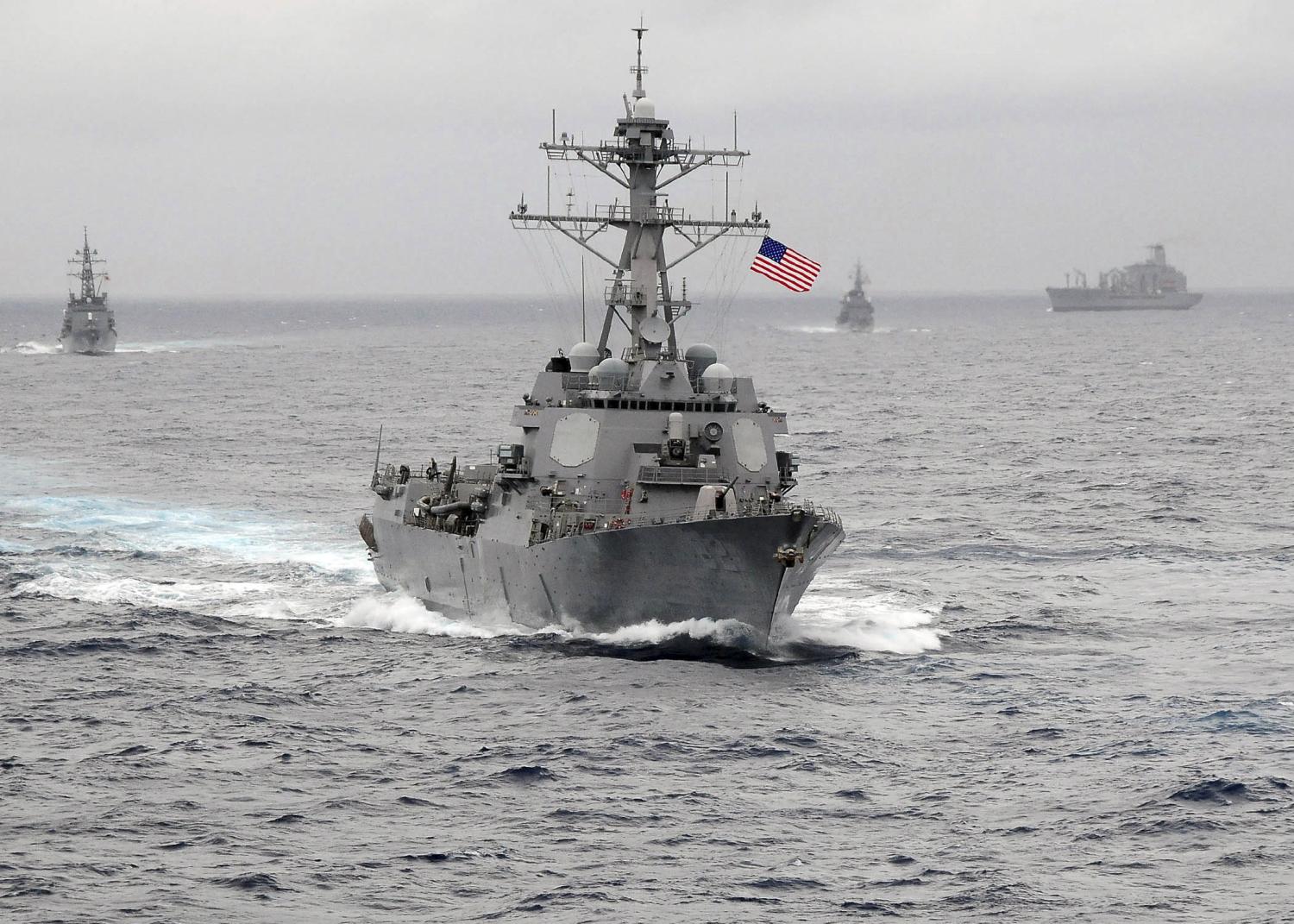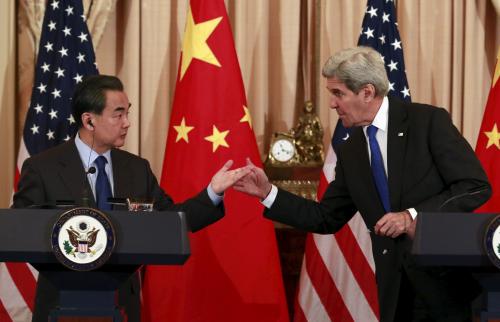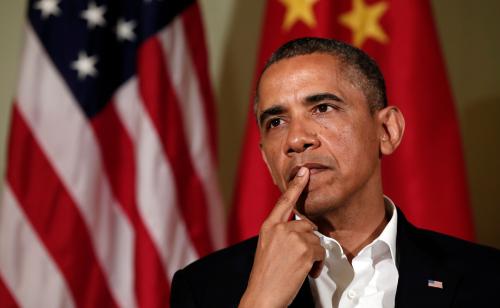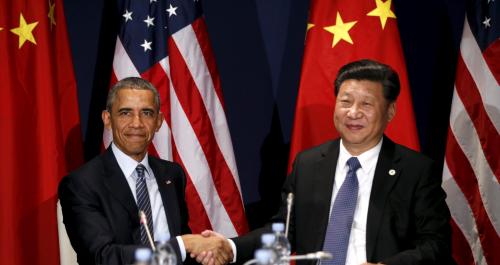The following brief is part of Brookings Big Ideas for America—an institution-wide initiative in which Brookings scholars have identified the biggest issues facing the country and provide ideas for how to address them. This policy brief has been adapted from a paper published as part of Brookings’s Order from Chaos series in March 2016. The original paper is available here. (Updated January 24, 2017)
 The manner in which the United States deals with China will be a critical, if not the critical, overseas challenge for the United States in the 21st century. What policy framework best optimizes our interests, which are multiple and not always consistent with each other?
The manner in which the United States deals with China will be a critical, if not the critical, overseas challenge for the United States in the 21st century. What policy framework best optimizes our interests, which are multiple and not always consistent with each other?
China presents unique challenges for the United States in formulating a coherent, effective policy. It is woven into the fabric of the global economic and trading system and is a major and frequently constructive player in international organizations. But it also has large gaps in its adherence to global rules.
There are three broad options for the United States to respond to the China challenge: 1) accommodation; 2) containment, confrontation, or untrammeled strategic rivalry; and 3) global cooperation paired with regional resolve. The third option is best, in my view, because we need to find a middle course that would safeguard the array of conflicting interests we have. U.S.-China cooperation is possible on many global issues, which has already been demonstrated on climate change, cooperation in the P5+1 negotiations to roll back Iran’s nuclear weapons program, and foreign assistance, for example.
The United States will need to seek a balance between accepting a larger global role for a constructive China while building barriers and coalitions against coercion in China’s neighborhood. On global issues, a sensible approach should look for issues on which China, because of its own evolving interests, can and should play a greater role in supporting the global system. Examples include cybersecurity and cyber innovation, protecting the rights of foreign investors, central bank coordination, and protection of intellectual property rights. This middle policy may lack the bracing shock value of accommodation or untrammeled rivalry, but the burden is on their advocates to explain how a radical lurch in either direction would secure the complex range of U.S. interests in our relationship with China.
Introduction
Serious people understand that the manner in which the United States deals with China will be a critical, if not the critical, overseas challenge for the United States in the 21st century. China will likely be the largest economy in the world within one or two decades; the second or third strongest military soon, if not already; and competitive with the United States and Europe in global economic, and perhaps political and cultural, influence in some regions. China is ruled by a Communist Party resistant to political liberalization at home and wedded to nationalist rhetoric and behavior in dealing with its neighborhood, enhancing the chances for rivalry with the United States.
For those students of history who see conflict as the likely outcome when rising powers encounter dominant powers, these are precursors of a dark future.
How should we deal with China? What policy framework best optimizes our interests, which are multiple and not always consistent with each other? Americans are in the midst of an ongoing presidential campaign that, in a better world, would be asking and answering such questions, but this is not such a campaign.
The Balance Sheet
Elsewhere, I have described how China’s leader, Xi Jinping, sees the world and its governance.1 Xi is a strong and innovative leader, but not someone who stands apart from modern Chinese history in his objectives. He appears different from his predecessors, however, because the China he rules is very different in its capacities and capabilities. Xi is moving more rapidly and assertively toward achieving some of China’s goals, but he is generally operating along well-traveled paths within post-1949, and especially post-1978, China. These goals include, inter alia:
- Maximizing Chinese influence in the Western Pacific;
- Building Chinese economic ties with and leverage over the countries of the region;
- Seeking reunification with Taiwan and asserting Chinese territorial claims (especially in maritime areas) against competitors;
- Strengthening the military and the military’s reach;
- Pursuing regional economic policies designed to increase inter-connectivity with China while playing a larger role in existing multilateral mechanisms; and
- Maintaining a positive and beneficial relationship with the United States while preparing for possible strategic rivalry.
Xi’s actions broadly have been within these parameters, but with China’s expanding capabilities have come actions that have greatly unsettled its neighbors and called into question whether its rise will be peaceful or threatening. Its construction of artificial islands in the South China Sea and deployments of radars and surface-to-air (SAM) missiles have compounded anxieties about its intentions. Its challenge to Japan’s control of the Senkaku islands in the East China Sea has had a similar impact. While supporting denuclearization of North Korea, it has failed to assert significant pressure on Pyongyang to roll back its nuclear program, indeed focusing its anger instead on South Korea for plans to deploy a U.S.-supplied missile defense system (THAADS) designed to protect the South against missile attack. While narrowing space for political dissent at home, it has signaled tighter limits to democratic development and political heterodoxy in Hong Kong and warned Taiwan of the consequences of deviation from the one China principle under its incoming president. Its navy is expanding in capacity and geographic reach. Its cyber-hacking and cyber-espionage are on a scale that alarms governments, militaries, and corporations. It has developed a strategic partnership with Russia that goes well beyond the transactional relationship the two powers enjoyed before.
…with China’s expanding capabilities have come actions that have greatly unsettled its neighbors and called into question whether its rise will be peaceful or threatening.
These are the goals China is pursuing, and some of the things it is doing. It also is important to note what China is not doing, or at least has not yet done:
- It is not seeking wholesale revision of the global order. Its creation of an Asian Infrastructure Investment Bank (AIIB) rivaling the World Bank and Asian Development Bank has launched a host of narratives premised on that thesis, but why then is the AIIB open to the major economies of Europe, hiring Americans and Europeans from World Bank backgrounds in many of its key management positions and eagerly voicing its determination to live up to the highest international standards? And why is China not structuring the AIIB’s rules to give it an effective veto power over loan decisions?
- It has not sent military forces to intervene in any foreign conflicts in over three decades.
- While it may resort to strong-arm tactics against Taiwan’s new government, the chance that it will use military force to seek re-unification in the near- to medium-term future is very slight.
- It has not attacked any island in the South and East China Sea occupied by another claimant.
- It asserts it has no intention to challenge the United States for global supremacy and has not built an alliance system to support its goals.
Above and beyond the troubling things China has done, and the troubling things it has not done, it is important also to take note of the contributions it has made, either by design or by sheer presence, to global prosperity:
- It has become the largest trade and investment partner of virtually every country in Central Asia and the largest trade partner of every country in East and Southeast Asia.
- It rivals Canada as the number one trading partner of the United States.
- It has become a significant global investor, including in the United States.
- It has provided substantial bilateral economic aid to numerous countries in Asia, Africa, and Latin America.
- Its currency will soon be included in the global reserve currency basket utilized by the International Monetary Fund for balance of payments transactions.
Policy Options for the United States
China presents unique challenges for the United States in formulating a coherent, effective policy. It is woven into the fabric of the global economic and trading system and is a major and frequently constructive player in international organizations. But it has large gaps in its adherence to global rules. Its rapid rise from poverty and the margins of the international system mean it is still a work in progress, with an unpredictable trajectory. Uncertainty about its future aims and ambitions creates legitimate debate about U.S. choices, especially since the choices we make will influence how China views the United States and its own opportunities and challenges.
There are three broad options for the United States to respond to the China challenge. All have their prominent advocates in the current policy literature:
- Accommodation. Its proponents see the rise in Chinese influence, particularly in the Western Pacific, as inevitable, producing a China that is the region’s center of gravity, an inevitable outcome that they say the United States should accept. Some who advocate this view believe Chinese ambitions are considerable but limited—national unification including Taiwan and the land features and associated waters of the South China Sea; a diminished role for U.S. alliances; and reduction in U.S. basing, patrols, and military presence in the Western Pacific. In their eyes, U.S. resistance to these ambitions will prove fruitless but will feed China’s hostility and ambitions. They contend that the United States will need to make hard choices among its global and domestic priorities and that maintaining military preeminence in the Western Pacific should be abandoned.
- Containment, confrontation, or untrammeled strategic rivalry. This school argues that China’s ambition is to dominate the Western Pacific and its periphery. It aims to expel the United States from the region, or at least marginalize the U.S. military, attenuate or destroy U.S. alliances, and bring the other countries of the region into submissiveness to Chinese preferences and interests. It believes that U.S. and Chinese interests regionally, and perhaps globally, are fundamentally incompatible, and we should acknowledge this if we are to adopt a coherent strategy. Usually, but not always, advocates of this approach emphasize the dominant role of the Chinese Communist Party, internal repressiveness, and clashing values with the United States. They point to China’s rapid expansion of its military capabilities and foresee a day before long when they will be used to achieve its nationalist goals, either through military force or intimidation. Therefore, they call for the United States to marshal its political, military, and economic tools to prevent China from becoming the preeminent regional power and to maintain U.S. regional dominance.
- Global cooperation, regional resolve. People in this camp believe that there are elements in approaches 1 and 2 that are sound but that aggressive and exclusive pursuit of either option is neither required nor desirable. In the eyes of advocates of option 3, the accommodation option would accept a second class status for the United States in the region by choice, not necessity. The untrammeled rivalry option would deprive us of the benefits of a constructive relationship while locking in a destructive competition that would fail to enhance our security. Supporters of option 3 believe that the relationship with China cannot, and should not, be reduced to one of pure rivalry, nor should we overlook the very real strategic differences in the Western Pacific between us.

Problems with Accommodation and Untrammeled Rivalry
Both the accommodation and the untrammeled rivalry frameworks focus largely on security issues. In today’s interconnected world, the notion that the world’s largest and second largest economies, with massive interdependencies in markets, trade, and investment, can build a relationship serving their national interests treating these economic relationships as a footnote is absurd. So a logical starting point for thinking about our relationship with China is to pay as much attention to the economic relationship as to the security relationship. Our economic relationship is likely to have dissonance as well as harmony, but it is important for Americans and Chinese alike in thinking about their interests to understand that fundamentally this is an area where we are bound together and which we need to make work.
The United States has done much to accommodate China since President Nixon’s visit. We have recognized the People’s Republic of China (PRC) as the sole legal government of all of China, despite the fact that it does not control Taiwan. We have terminated our mutual security treaty with Taiwan and closed our bases there. We have opened up the United States to exports from China exceeding those from any other country and given a green light for American investment in China, fueling its economic growth. American universities have provided education for hundreds of thousands of Chinese students, bringing science, technology, and expertise to a nation that desperately needed them. We have helped bring China into most of the world’s institutions where we are the gatekeeper. We have done these things not as a favor to China but because we judged them in our national interest.
But there are sensible limits we need to impose on how far accommodation should go. We cannot endanger the security of our allies in the region without paying an unacceptable cost, regionally and globally. Our alliances with Japan and South Korea not only bring mutual benefit, but are foundations of regional stability that would leave a dangerous vacuum if they were weakened. We should not accept a transformation in which Chinese economic dominance translates into security submission by its neighbors. Signals to the region that the balance of power is shifting, with American encouragement, from the world’s most open, democratic, and pluralistic country to a country whose political system remains repressive; whose adherence to global norms on human rights, the law of the sea, corrupt practices, and transparency is weak; and whose nationalist ambitions are threatening to many would be destructive and destabilizing. Indeed, most of the countries are more interested in demonstrations of American strength and staying power than in signs of U.S. restraint and modesty.
Untrammeled strategic rivalry with China may become a reality if Chinese conduct requires it, but it is not something we should encourage, nor embrace lightly without understanding the costs. In a world filled with chaos, terrorism, nihilism, civil war, and anarchy, Asia is a relative beacon of stability, economic openness, and dynamism. It is not in U.S. interests to end or undermine that by launching a new cold war, which would raise regional tensions, fail to gain support of regional powers, and dampen economic growth. Given the array of challenges the United States faces globally, especially in the greater Middle East, the kind of single-minded focus we brought to bear in facing the Soviet challenge cannot be repeated. In any case, China has not been creating an empire of satellite states, using force to conquer or destabilize neighbors, or subverting other countries as the Soviets did. Its challenge is more subtle, and so should be our response.
…most of the countries are more interested in demonstrations of American strength and staying power than in signs of U.S. restraint and modesty.
In their extreme versions, the strategies of accommodation and untrammeled rivalry make assumptions about American resilience and Chinese strength that are dubious.
The accommodation argument, much like the contention in the 1970s that the United States needed to accommodate radically to an emerging multipolar world, seems to project a United States that remains static, that fails to innovate, and that proves unable to maintain its military, political, economic, and cultural advantages. As Lee Kuan Yew said, those who bet against the United States in the 20th century didn’t come out so well, and we have it in our power to ensure, through domestic rejuvenation, that the America short-sellers in the 21st century meet the same fate. A central premise of accommodation also seems to be that China’s rise has a kind of inevitability about it, and that the trajectory of U.S. and Chinese economic strength and national power are converging. Recent weakness in the Chinese economy and signs that systemic reform will remain very challenging undercut the notion that we can make straight line projections from China’s success in the last 20 years in moving from underdevelopment to medium income status.
The argument for embrace of untrammeled strategic rivalry makes more confident assumptions about U.S. strength and adaptability. But it does not persuasively explain how the United States will be able to subordinate other demanding domestic and foreign priorities to confronting the ambiguous challenge that China poses. Like the proponents of accommodation, its advocates sometimes postulate a China that is 10 feet tall and whose nefarious intentions and secret master plan lie behind normal developments. It dismisses, incorrectly in my view, the wisdom in the trope that if we treat China as an enemy, it will surely become one. Security rivalries lead to security dilemmas and distort destructively the behavior of those trapped in them. If we conspire to make China an enemy, then every problem we deal with, including Iran, North Korea, climate change, and global terrorism, will become orders of magnitude more difficult to manage. Finally, confrontation with a country that will be our number one trading partner, the major trading partner of many of our friends in Asia and elsewhere, and a foundation of the global economy will impose considerable costs on our own economy and those of numerous other countries and create severe strains with friends who would be negatively impacted.
Elements of a Successful Option 3
State Department lore—derived from an observation by Henry Kissinger—has it that an option memo for decision by the secretary of state should always have three options: 1) Nuclear war; 2) Surrender; and 3) A sensible middle-of-the-road diplomatic solution. Just because it’s a joke, and just because option 3 lacks the clarity of options 1 and 2, does not mean that option 3 is just an easy escape from hard thinking. Sometimes, indeed often, the option 3 template provides the right way of thinking about the issue, even in cases where options 1 and 2 are less extreme. In the case of U.S. policy toward China, I believe it does.
In this instance, option 3 is not entirely alien to options 1 and 2. U.S. policymakers will have to recognize that some degree of accommodation of China’s rise is necessary, and so is some degree of strategic rivalry with China. The goal should be to find a middle course that would safeguard the array of conflicting interests we have.
U.S.-China cooperation should be possible on many global issues. The recent bilateral agreement on climate change, in which the world’s two largest emitters of greenhouse gases acknowledged their responsibilities for action, illustrates the possibilities in one domain. China’s cooperation with the United States in the “Permanent 5+1” negotiations to roll back Iran’s nuclear weapons program offers another example. In the area of foreign assistance, China’s programs have a different focus than America’s, and this offers potential qualitative and quantitative benefits for recipient developing countries.
Since China’s opening to the outside world began in earnest in 1978, U.S. policy has been built around the objective of bringing the PRC into the major international economic and security institutions and demanding of Beijing that it accept and play by the rules of these institutions and associated international norms. This strategy has had major successes, as China has become an active and necessary actor in the United Nations, World Trade Organization (WTO), International Atomic Energy Agency, nonproliferation regimes, World Health Organization, and a host of other international organizations. In that process, Chinese companies and individuals have emerged as if from a deep sleep and played an important role in driving global economic growth. On the security side, China’s record has been mixed, but on global issues it has not been a provocateur.
The picture in East and Southeast Asia, however, is not so comforting. As noted above, China’s actions in the South China Sea, the East China Sea, and vis-à-vis Taiwan and Hong Kong keep the region on edge. While Beijing opposes North Korea’s nuclear weapons program and has occasionally supported actions to condemn and limit it, it has often indulged North Korean provocations and weapons tests with a morally obtuse and strategically dubious even-handedness between North Korea and the United States. Its military buildup has radically altered the balance between China and its neighbors and created anxiety all along its periphery.
So it appears for the immediate future that there is an imbalance between the China regional challenge and the China global challenge. In the East Asian region, China’s policies and ambitions increasingly conflict with U.S. interests and threaten the region’s equilibrium. On the global stage, China’s actions and role are less potentially disruptive, even stabilizing.
What kind of actions should the United States take to achieve a balance between acceptance of a larger global role for a constructive China while drawing lines against coercion in China’s neighborhood? While individual actions will be enormously important, it is less useful in looking ahead to prescribe specific steps that will depend upon particular situations and more useful to think about the big picture, the framework in which these steps will occur.
In the East Asian region, China’s policies and ambitions increasingly conflict with U.S. interests and threaten the region’s equilibrium. On the global stage, China’s actions and role are less potentially disruptive, even stabilizing.
Some of the most important actions the United States can take have nothing to do directly with China but will arguably have greater impact than our actions in the region. The reality and image of the United States as a properly functioning democracy, which have suffered greatly with our national political dysfunctions on display, can have a multiplier effect on our foreign policy—as does our willingness to offer international leadership, to provide the necessary resources to support a serious foreign policy, and our demonstrating that we are neither turning inward nor reducing foreign policy engagement to simply fighting terrorists.
On global issues, a sensible option 3 approach should look for issues on which China, because of its own evolving interests, can and should play a greater role in supporting the global system. This should not be a matter of the United States browbeating a resistant China into adopting our practices and standards contrary to their interests, but rather figuring out where China can alter its practices for its own purposes and act as a constructive global citizen.2 A few examples:
- Cybersecurity, and cyber innovation. China does not want its cyber networks to be hacked, and it should not wish to see its development of cyber capabilities isolated from global innovation. China of course has vastly different conceptions from the United States on cyber issues—emphasizing control and national sovereignty—but these areas of potential overlap should be explored and developed.
- Protection of the rights of foreign investors. With China rapidly becoming one of the world’s leading sources of overseas capital, it should be increasingly concerned about the rights of investors, not merely ensuring that it can attract foreign investment and squeeze advantage from it.
- Adoption of the standards of the Foreign Corrupt Practices Act. China has long seen it as a competitive advantage in its overseas projects to have loose standards about bribery and payoffs to foreign officials. But with Xi Jinping now engaged in a high profile campaign against corruption at home, it would make sense for China to reexamine its overseas practices to make them conform to what Xi is trying to do domestically. Otherwise, toleration of corruption in one setting inevitably will lead to toleration in other settings.
- Central bank coordination, especially at times of global market instability. China should be brought more into the coordination among the G-7 central banks and finance ministries than it has to date, since its impact on global markets, and the impact of global trends on its market, greatly accede that of some other G-7 members.
- Fisheries treaties and conservation. China is the biggest fish-catching and fish-eating country in the world, with some 14 million people earning their living from fishing. China should have a concern about overfishing and depletion of stocks. Historically, Chinese fleets have been a source of overfishing. They should see an interest in transforming their activities. This could be a good place as well to start in confidence-building in the South China Sea.
- Protection of intellectual property rights. As the number of Chinese patents grows, and as the number of Chinese companies going global expands, China’s interest in protection of intellectual property should converge with those of Western innovators.
There is important historical precedent for affecting Chinese practices on similar issues. For example, beginning in the 1980s, under pressure from the United States, China began to change its behavior in the area of proliferation of weapons of mass destruction, transforming from one of the world’s chief problem countries to one that respected international norms. Similarly, more recently, China has altered its approach to climate change issues, aligning with the United States in bilateral and multilateral settings in taking the issue much more seriously after years of resistance.
Other steps the United States should take in the global arena to protect our interests in the face of the Chinese challenge include:
- Exercise U.S. leadership in addressing regional areas of tension and instability, such as Syria, Iran, Afghanistan, Libya, and the Israeli-Palestinian conflict, while inviting Chinese active participation in efforts to resolve them and respecting Chinese interests.
- Support robust market-oriented economic reform in China that levels the playing field for private and foreign companies, including by negotiating a bilateral investment treaty or agreement that imposes commercial disciplines on state-owned enterprises and by granting China “market economy status” under WTO rules (note: this will be challenging during a presidential campaign but should be done as soon as it is politically feasible).
- Aggressively use the dispute settlement mechanism in the World Trade Organization and unilateral actions to protect technology and intellectual property of American companies.
- Restrict access to the U.S. market for companies that benefit from cyber-espionage directed at U.S. companies.
- Welcome a role in international institutions such as the World Bank and International Monetary Fund for China commensurate with China’s economic strength.
In the Asia Pacific area, elements of an option 3 strategy could include:
- Clarity about the solidity of U.S. alliance commitments, with diplomacy that sustains allies’ domestic support for these alliances, especially in Japan and South Korea. We should be unambiguous that the U.S. global and regional alliance system is a vital national interest, and challenges to it will be met firmly.
- Reinforcing U.S. military presence to demonstrate our ability to maintain our commitments and expanding the scope of bilateral military exercises and operations with allies and security partners.
- Seeking larger contributions to the U.S. security presence on the part of allies and partners in the region.
- Stressing to Beijing that North Korea’s nuclear and missile programs are a direct threat to U.S. national and regional security that compels stronger joint actions by the U.S. and China to ensure dismantling of these capabilities. Make clear American preference to work with Beijing to achieve this goal, but also that if Beijing fails to help, the U.S. will take necessary steps to defend its own security against North Korean WMD programs.
- Trilateral coordination among the United States, China, and South Korea on policy toward North Korea. Strengthened efforts to persuade China to use its influence more effectively to pressure North Korea to accept denuclearization combined with credible assurances to China that Korean reunification will not negatively affect its security interests.
- A Taiwan policy based on the maintenance of peace and stability in the Taiwan Strait, the U.S.-PRC Communiques and Taiwan Relations Act, our traditional “one China” policy, support for cross-Strait dialogue and economic and other exchanges, and security assistance to Taiwan that reduces the risk of coercion. Making clear to Beijing that the U.S. interest in the ability of Taiwan’s people to live free from intimidation is unchanged, regardless of who governs in Taiwan; but at the same time respecting the special sensitivity of the Taiwan issue in the PRC by refraining from bringing Taiwan into broader regional security arrangements.
- Active and visible U.S. Navy presence in the South China Sea through operations, exercises, and challenges to claims contrary to international law and norms. Maintain neutrality on territorial claims, pursue diplomacy aimed at eliciting conformity of Chinese maritime claims with the U.N. Convention on the Law of the Sea, and with the important ruling by the Permanent Court of Arbitration in the Hague relating to China’s dispute with the Philippines. Support negotiation of differences between China and the Philippines consistent with the UNCLOS and maritime law. Encourage accelerated negotiation of a code of conduct in the South China Sea.
- A human rights policy that makes China pay a price for extraterritorial seizures of citizens abroad and for interference with legitimate activities by U.S. information technology companies and citizens, while articulating U.S. values but making clear that China’s political system is for its citizens, not Americans, to decide.
- Working with Chinese-established institutions like the Asian Infrastructure Investment Bank to bring needed development projects to the region.
It is easier, of course, to state objectives than to realize results. Figuring out how to accomplish these objectives will depend heavily on particular circumstances. But that is not our purpose here. Rather, it is to describe the outlines of a comprehensive policy that has a balanced combination of resolve, especially in the Asia Pacific, and reassurance of our acceptance of China’s rise. The policy just described may lack the bracing shock value of accommodation or untrammeled rivalry, but the burden is on their advocates to explain how a radical lurch in either direction would secure the complex range of U.S. interests in our relationship with China.
-
Footnotes
- Jeffrey A. Bader, “How Xi Jinping Sees the World…and Why,” The Brookings Institution, February 2016, available at https://www.brookings.edu/~/media/research/files/papers/2016/02/xi-jinping-worldviewbader/xi_jinping_worldview_bader.pdf.
- I thank Robert Zoellick, who was responsible for introducing the idea of China becoming a “responsible stakeholder” into public policy dialogue, for suggesting that I look for examples where China might be interested in becoming a supporter of “systemic” concepts for its own reasons.








